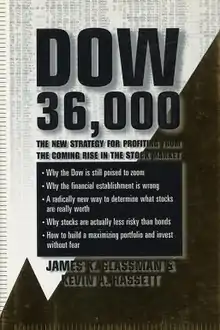Dow 36,000
Dow 36,000: The New Strategy for Profiting From the Coming Rise in the Stock Market is a 1999 book by syndicated columnist James K. Glassman and economist Kevin A. Hassett,[1][2] in which they argued that stocks in 1999 were significantly undervalued and concluded that there would be a fourfold market increase with the Dow Jones Industrial Average (DJIA) rising to 36,000 by 2002 or 2004.[3][4] The Dow was pushed down by the bursting of the dot-com bubble as the NASDAQ peaked in 2000 and bottomed out in 2002, and by the September 11 attacks in 2001. The Dow fell below 8,000 in 2002, remained below 12,000 until 2006, and below 30,000 until 2020, when it attained and exceeded said number for the first time.[5]
 | |
| Authors | James K. Glassman, Kevin A. Hassett |
|---|---|
| Working title | Dow 36,000 |
| Country | United States |
| Genre | Investments |
| Publisher | Crown Business |
Publication date | 1 October 1999 |
| Pages | 304 |
| ISBN | 978-0812931457 |
Context
Glassman and Hassett had predicted that the[3]
single most important fact about stocks at the dawn of the twenty-first century: They are cheap....If you are worried about missing the market's big move upward, you will discover that it is not too late. Stocks are now in the midst of a one-time-only rise to much higher ground–to the neighborhood of 36,000 on the Dow Jones industrial average.
— Glassman and Hassett. 1999. "Introduction." Dow 36,000
The book was published in 1999, shortly before the dot-com bubble burst, and predicted that stocks would rise quickly to 36,000. Although the DJIA reached a record high of 11,750.28 in January 2000, it fell steadily after the bursting of the dot-com bubble. Following the September 11 attacks of 2001, the DJIA fell further, reaching a low of 7,286.27 in October 2002. Although the DJIA recovered to a new record high of 14,164.53 in October 2007, it crashed back to the vicinity of 6,500 by the early months of 2009, amidst a global recession.
The book was largely discredited as misstating the risk characteristics of equity securities as equivalent to U.S. Treasury fixed income securities, it is commonly believed discredited for predicting a grossly inflated stock market.
Excerpts from the book were published in The Atlantic Monthly in 1999.[6] In the January 2000 issue of The Atlantic Monthly, Glassman and Hassett replied to a critic of their theory that "if the Dow is closer to 10,000 than to 36,000 ten years from now, we will each give $1,000 to the charity of your choice."[7] For the Dow to be closer to 10,000 than to 36,000, it would have to be below 23,000. As things turned out, the index was not even at half that figure ten years after Glassman and Hassett's prediction (the Dow's highest close in January 2010 was 10,725, reached on 19 January). In early 2010, Glassman and Hassett conceded they lost the bet and they each donated $1,000 to the Salvation Army.[8] It wasn't until 18 October 2017, coincidentally the day before the 30th anniversary of Black Monday, that the Dow closed above 23,000, thus finally reaching more than halfway from 10,000 to 36,000.[9]
Summary of main argument
According to John Quiggin, writing in the Australian Financial Review, Glassman and Hassett believed that both investors and official commentators had mistakenly considered stocks to be a risky investment which should require a premium return, when compared to 'safe' investments such as government bonds. They argued that if stocks and bonds were treated as equally risky, the Dow Jones index would be around 36,000. Hence, anyone who gets in now and stays for the long haul, can expect returns of around 300 per cent (in addition to the normal interest rate) as the rest of the market wakes up. Once this historic correction is over, the efficient-market hypothesis will hold sway.[10]
Quiggin situated Glassman and Hassett at a time when the economic boom in the United States of the 1990s had created "the renascence of the stock market"—the Dow Jones index had risen from 1000 in the early 1980s to more than 10,000 by 2000 with Nasdaq, a technology-based-index with an even more dramatic rise.[10]
On the optimistic side, Glassman and Hassett argue that a buy-and-hold strategy based on the blue-chip stocks that make up the Dow Jones index will yield 300 per cent returns over the next few years. Shiller views suggestions with alarm and suggests staying on the sidelines until the current bout of 'irrational exuberance' comes to its inevitable end.
References
- "Review of Dow 36,000", Publishers Weekly, 1999, retrieved 12 April 2017
- James K. Glassman and Kevin A. Hassett (1 October 1999). Dow 36,000: The New Strategy for Profiting From the Coming Rise in the Stock Market. Crown Business. pp. 304. ISBN 978-0812931457.CS1 maint: uses authors parameter (link)
- "Introduction: Why Stocks Are Such a Good Buy", World Catalogue, Dow 36,000, September 1999, retrieved 12 April 2017
- Paul Krugman, Dow 36,000: How silly is it?, MIT, retrieved 12 April 2017
- Wursthorn, Gunjan Banerji, Akane Otani and Michael (24 November 2020). "Behind Dow 30000: A Self-Perpetuating Upward Cycle". The Wall Street Journal. ISSN 0099-9660. Retrieved 24 November 2020.
- James K. Glassman and Kevin A. Hassett (September 1999), "Dow 36,000", The Atlantic, retrieved 12 April 2017CS1 maint: uses authors parameter (link)
- James K. Glassman and Kevin A. Hassett (January 2000), "Dow 36,000", The Atlantic, LettersCS1 maint: uses authors parameter (link)
- James K. Glassman and Kevin A. Hassett (May 2010), "Dow 36,000", The Atlantic, Letters, retrieved 12 April 2017CS1 maint: uses authors parameter (link)
- Eisen, Ben; Jimenez, Ken; Destefano, Tom. "Dow's Climb Above 23000 Comes 30 Years After Black Monday". The Wall Street Journal.
- John Quiggin (1 September 2000), "Taking stock of irrational exuberance", Australian Financial Review, retrieved 12 April 2017